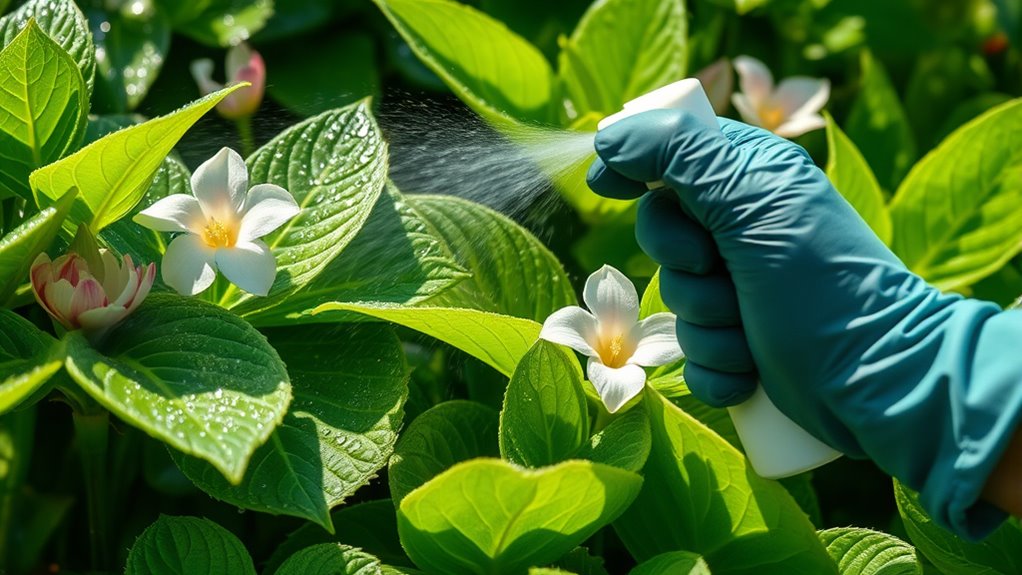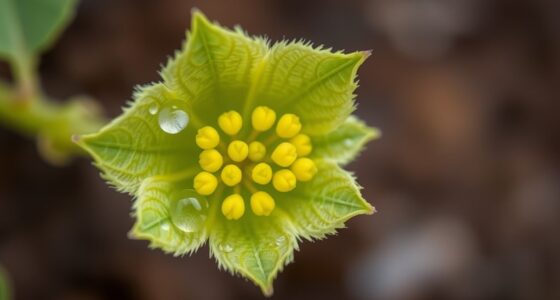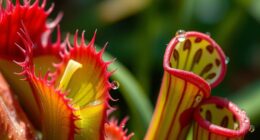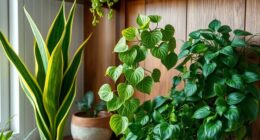To prevent summer rot in your rare plant collection, focus on maintaining healthy, well-drained soil and regular nutrient testing. Keep foliage dry by watering early in the day and ensuring good air circulation through proper spacing and pruning. Inspect plants frequently for pests and act quickly to control infestations using organic methods or beneficial insects. Regular sanitation, like removing debris and disinfecting tools, supports disease prevention. Continue exploring these strategies for healthier, resilient plants all summer long.
Key Takeaways
- Maintain well-drained, healthy soil by testing pH, amending with compost, and avoiding overwatering.
- Improve air circulation through proper spacing, pruning, and ensuring adequate airflow around plants.
- Water early in the day to allow foliage to dry, reducing fungal and bacterial growth.
- Regularly inspect plants for early signs of disease and remove fallen debris to prevent pathogen spread.
- Use integrated pest management and biological controls to minimize pest-related disease transmission.
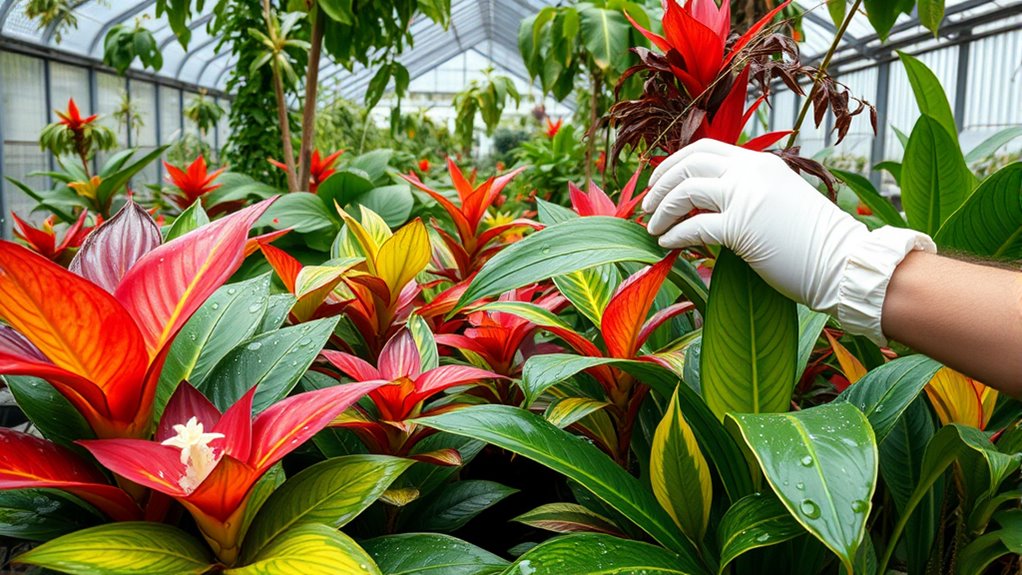
How can you effectively prevent diseases in your rare plant collections? The key lies in maintaining healthy soil and implementing proactive pest management strategies. Healthy soil forms the foundation of disease prevention because it supplies plants with essential nutrients, boosts their natural defenses, and creates an environment less favorable for pathogens. To achieve this, regularly test your soil to monitor pH levels and nutrient content, then amend it with organic matter or compost to improve its structure and microbial diversity. Avoid overwatering, which can lead to waterlogged soil, a prime condition for root rot and other fungal diseases. Ensuring proper drainage is essential, especially during the hot summer months when excess moisture can quickly become a problem.
Maintain healthy, well-drained soil to prevent root rot and fungal diseases in your rare plant collection.
Pest management plays a crucial role as well, since pests can transmit diseases directly or weaken plants, making them more susceptible to infections. Regularly inspect your plants for signs of pests like aphids, scale, or mites, and act swiftly if you notice any issues. Use integrated pest management (IPM) techniques, combining physical removal, biological controls, and targeted organic treatments to keep pest populations in check without harming beneficial insects. Introducing natural predators or beneficial insects like ladybugs can reduce pest numbers naturally, decreasing the need for chemical interventions that might damage your plants or soil health.
Another effective way to prevent summer rot and related diseases is to improve air circulation around your plants. Proper spacing and pruning help reduce humidity levels and airflow stagnation, both of which create ideal conditions for fungal growth. Keep foliage dry by watering early in the day, allowing leaves to dry before evening, because excess moisture on plant surfaces encourages fungal spores to develop. Clean and disinfect your tools regularly to prevent spreading pathogens from one plant to another. Remove any fallen leaves or debris promptly, as they can harbor diseases that thrive in decaying matter.
Monitoring your collection closely during the warmer months is essential. Be vigilant for early signs of disease, like discolored or wilting leaves, and act quickly to isolate and treat affected plants. Employ preventive fungicides sparingly and only when necessary, focusing more on cultural practices that promote plant health. Maintaining proper lighting conditions and ensuring adequate airflow are also critical components of disease prevention. By prioritizing soil health and pest management, you create an environment where your rare plants can thrive, resist diseases, and withstand the stresses of summer heat. Consistent care, combined with a keen eye and prompt action, will considerably reduce the risk of summer rot and help preserve your collection’s beauty and vitality.
Frequently Asked Questions
How Do I Identify Early Signs of Summer Rot in Rare Plants?
To identify early signs of summer rot in your rare plants, keep an eye on soil moisture levels; overly wet soil often indicates trouble. Watch for leaf discoloration, such as yellowing or browning, which can signal stress or disease. Regularly inspecting your plants and maintaining proper watering practices help you catch problems early, preventing serious damage. If you notice these signs, act quickly by adjusting watering and improving drainage to protect your collection.
Are There Organic Methods to Prevent Summer Rot Effectively?
You can use organic methods to prevent summer rot effectively. Applying organic sprays like neem oil or copper-based solutions creates a natural barrier against fungal infections. Additionally, natural remedies such as compost teas or diluted chamomile extract can boost plant immunity. Regularly inspect your plants for early signs of trouble, and guarantee good airflow and proper watering practices to keep your rare plants healthy and rot-free all summer long.
What Specific Environmental Conditions Promote Summer Rot?
Soggy, stagnant, and sweltering conditions markedly promote summer rot. When soil moisture stays high and humidity control fails, pathogens thrive, spreading rapidly through damp, dense environments. Excessive water retention and poor airflow foster fungal and bacterial outbreaks, risking plant health. To prevent this, you should manage soil moisture carefully and guarantee good air circulation, reducing the risk of summer rot and maintaining healthier, happier plants.
Can Pruning Help Reduce Disease Spread in Collections?
Pruning techniques are essential for disease management strategies in your collection. By removing infected or dead plant parts, you reduce the chances of disease spread. Use clean, sharp tools and prune early to improve airflow and minimize moisture retention, which encourages rot. Proper pruning not only keeps plants healthy but also helps prevent summer rot by limiting fungal and bacterial growth, making it a crucial step in your overall plant care routine.
How Often Should I Inspect Plants for Signs of Disease?
You might think checking your plants is time-consuming, but regular inspections are vital. Inspect your plants weekly for signs of disease, especially after rain or high humidity. Use plant quarantine procedures for new additions and choose disease-resistant varieties when possible. Early detection helps you catch issues before they spread, saving your collection. Staying vigilant ensures your plants stay healthy and vibrant, preventing summer rot and other diseases effectively.
Conclusion
To keep your rare plant collection thriving, gentle attention and proactive care are essential. By tending to your plants with patience and understanding, you help them flourish even during the warmest months. Remember, a little extra care now can prevent more serious challenges later. Embrace the opportunity to nurture your collection thoughtfully, ensuring it remains a beautiful, resilient treasure for years to come. Your dedication truly makes all the difference.

